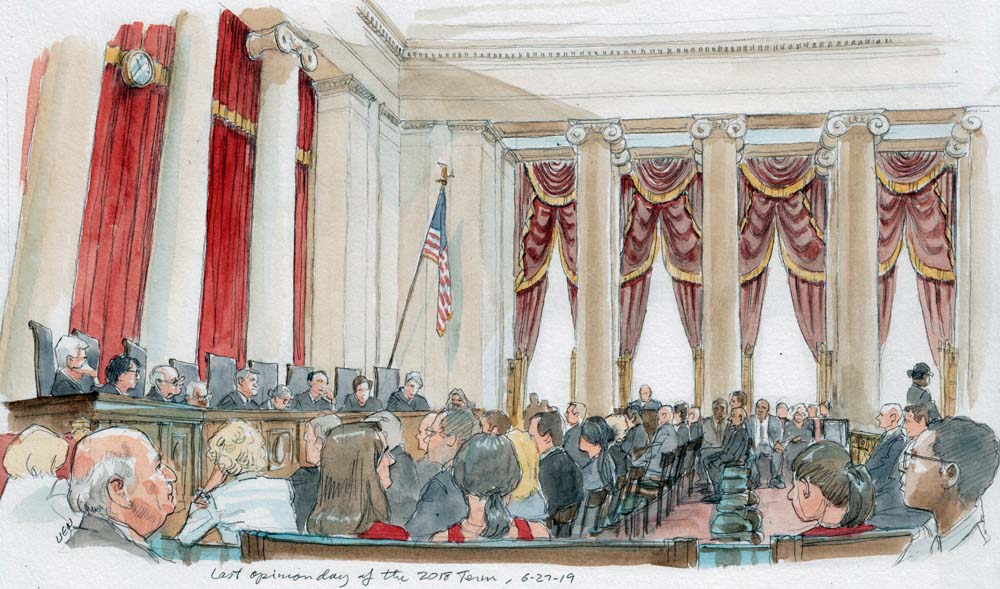Final Stat Pack for October Term 2018

on Jun 28, 2019 at 5:59 pm

The Supreme Court term is now complete, resolving cases that had generated months of speculation. Chief Justice John Roberts wrote majority opinions in two of the most anticipated decisions of the term, Department of Commerce v. New York and Rucho v. Common Cause, bringing his total majority-opinion authorship count to seven. Other justices wrote six to eight majority opinions each. The justice who wrote the most total opinions this term was Justice Clarence Thomas with 28, including eight majority opinions, 14 concurrences and six dissents.
With Justice Brett Kavanaugh joining the Supreme Court in October, much of the discussion this term has centered on how the new justice would fit in on the court and mesh with the other sitting justices. If finding agreement was his goal, Kavanaugh seems to have done an effective job. Kavanaugh had the highest frequency in the majority of the justices, at 91 percent. Roberts was second highest at 85 percent. Kavanaugh and Roberts also shared the highest agreement level for any justice pairing this term, at 94 percent. The second-highest agreement level was between Justices Ruth Bader Ginsburg and Sonia Sotomayor, who agreed in 93 percent of their votes.
While Kavanaugh shared high agreement levels with several of the other more conservative justices on the Supreme Court, his agreement levels with some of the more liberal justices were on the high side as well. Kavanaugh’s votes aligned with Justice Samuel Alito’s 91 percent of the time and his agreement level with Thomas was at 80 percent. Below this, Kavanaugh agreed equally often with Justices Stephen Breyer, Elena Kagan and Neil Gorsuch, at 70 percent apiece. Kavanaugh’s agreement level with Gorsuch was on the very low end of the scale when we look at agreement levels between two justices appointed by the same president in their first full term together over the last half century.
Turning to Gorsuch, he is the conservative justice who sided with the more liberal justices in the most five-vote majority decisions this term, with four. Each of the other conservative justices, including Kavanaugh, voted with the more liberal justices in one five-vote majority, for a total of ten decisions. The five more conservative justices voted together seven times in five-vote majorities.
Gorsuch authored three 5-4 decisions this term, including two in which the four more liberal justices were also in the majority — United States v. Haymond and United States v. Davis. In terms of his agreement levels, Gorsuch’s highest for the term was with Thomas, at 81 percent. His agreement with Roberts was substantially lower, at 68 percent.
When we look at the justices’ total opinion-page output for the term, Gorsuch was at the top. Gorsuch wrote 337 total opinion pages (including majority opinions, concurrences and dissents), which was just higher than Alito’s 324 pages. Kavanaugh wrote the second fewest total opinion pages, at 169. Ginsburg was the only justice to write fewer, with 131 (Ginsburg also had the fewest majority opinion assignments this term, with six.).
Ginsburg was the quickest majority-opinion writer this term when we look at time between oral arguments and decisions. Her average time of 71 days far outpaced any of the other justices. Ginsburg also wrote two of the three quickest decisions based on this measure, with Mount Lemmon Fire District v. Guido at 36 days and Fort Bend County, Texas v. Davis at 42 days. Alito took the longest average time of the justices at 132 days, followed by Kagan at 128 days and Gorsuch at 118 days. Kagan wrote the decision that took the longest time from oral argument this term, Gundy v. United States, at 261 days. This was a record length of time for an opinion under Roberts.
Looking at the macro level, the justices voted unanimously in 28 cases this term, which equates to approximately 39 percent of the time. This is on the low end for a term since Roberts took over as chief and almost 30 percent lower than the highest percentage of unanimity for a term since 2005, which was 66 percent in 2013.
When we examine the Supreme Court’s treatment of cases from lower courts, decisions from cases that came from the U.S. Court of Appeals for the 9th Circuit stand out. Out of 14 cases the court voted on that came from the 9th Circuit, the court reversed 12 and only affirmed two, for an 86 percent reversal rate. The reversal rate was higher for only one circuit, the U.S. Court of Appeals for the 7th Circuit, at 100 percent, but the court only decided a single case previously heard by the 7th Circuit.
Going into the 2019 term, the Supreme Court has already granted 50 cases, which, when certain cases are consolidated, will lead to 41 oral arguments. This includes Carpenter v. Murphy, which was set for reargument in the fall. Many of these cases raise important issues of public concern, including the newly granted cases addressing Deferred Action for Childhood Arrivals, or DACA, and a case reviewing a provision of the Affordable Care Act.
- Complete Final Stat Pack
- Cover Sheet
- Opinions By Sitting
- Circuit Scorecard
- Merits Cases By Vote Split
- Term Index
- Makeup of the Merits Docket
- Total Opinion Authorship
- Total Opinions Over Time
- Opinions Authored By Each Justice
- Workload
- Summary Reversals
- Majority Opinion Authorship
- Strength of the Majority
- Unanimity
- Frequency in the Majority
- 5-4 Cases
- Majority Opinion Distribution
- Justice Agreement
- Time Between Oral Argument and Opinion
- Pace of Grants
- Pace of Opinions
- Grants Per Conference
- Opinions Per Week
- Oral Argument — Justices
- Oral Argument — Advocates
- Voting Alignment — All Cases
- Voting Alignment — 5-4 Cases
Andrew Hamm provided invaluable assistance in producing this Stat Pack. Thanks also to Jon Levitan for his help maintaining the voting-alignment charts.


